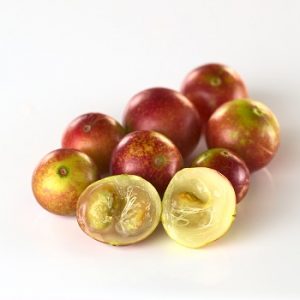
More evidence that low-calorie sweeteners are bad for your health
Studies show that artificial sweeteners can raise the risk of hypertension, metabolic syndrome, type 2 diabetes and heart disease, including stroke.

The grape-sized red and purple berries of the camu camu plant are the latest Brazilian superfood to wow the health supplement market.
This truly is a new age food. There is no real documented use of camu camu as a traditional herbal remedy in the Amazon region. In fact, because of its naturally acidic taste it was not widely eaten as a fruit by the indigenous people there.
For the modern food market, the fruits, which grow to about the size of a lemon, are juiced directly after harvest and then freeze dried onto a tapioca root starch base. The tapioca base has a semi-sweet taste which balances out the acidity of the fruit and is a good carrier for blending camu camu into juices, smoothies and yoghurt.
Nutrient rich
Camu camu (Myrciaria dubia) belongs to the myrtle or Myrtaceae, family which also includes the bay rum tree, clove, guava, acca (feijoa), allspice, and eucalyptus .
It grows abundantly in the floodplains and swamps along rivers and lakes in Amazonian Peru, Brazil, and Venezuela.
Apart from being one of the highest recorded sources of vitamin C of any plant, camu camu is also rich in a variety of powerful nutrients including a variety of antioxidant compounds, which contribute to its benefits for health.
Research on the health benefits of camu camu is rather limited, but we know a great deal about its various constituents which suggest that it can be a useful supplement to a healthy diet.
Vitamin C
At around 2 grams of ascorbic acid per 100 grams of mature fruit, camu camu has the highest recorded levels of vitamin C of any fruit, surpassing even the highest levels recorded in the acerola. Because it is so high in this important antioxidant just a teaspoon of the dried powder is more than enough to meet your daily vitamin C necessary to support immune function (especially against viruses), and maintaining healthy gums, eyes, skin, and connective tissue.
Gallic Acid
Gallic acid, an important antioxidant found in abundance in green tea, is also a component of camu camu. It has both anti-fungal and anti-viral properties.
Ellagic Acid
Ellagic acid is another antioxidant found naturally in a wide variety of foods such as grapes, nuts, strawberries, blackcurrants, raspberries, green tea, pomegranates, nuts and the stem and bark of Eucalyptus globulus. Some laboratory research suggests it has anti-cancer as well as anti-inflammatory and anti-diabetes properties.
Amino acids
Camu camu contains valine, leucine, and serine, three amino acids that assist with muscle growth and repair, prevent muscle breakdown, and aid digestion.
Tackling inflammation
Not much human data exists on the benefits of eating camu camu. But one study suggests it may help fight inflammation and oxidative stress.
For the study, 20 male smokers either drank camu camu juice or took vitamin C tablets every day for a week. At the end of the treatment period, members of the camu camu group showed a significant decrease in certain markers of inflammation and oxidative stress. Members of the vitamin C group, meanwhile, did not experience a decrease in these markers.
How to use it
Camu camu is sold in healthfood stores and online in powder form and sometimes as tablets. The powder is useful for flavouring or mixing into other foods. Try adding half to one teaspoon daily to yoghurt, smoothies, juices, tea, desserts or superfood ‘buzz’ balls.
Our Super C boost Tropical Smoothie recipe includes antioxidant rich camu camu to give you a boost.

Please subscribe me to your newsletter mailing list. I have read the
privacy statement